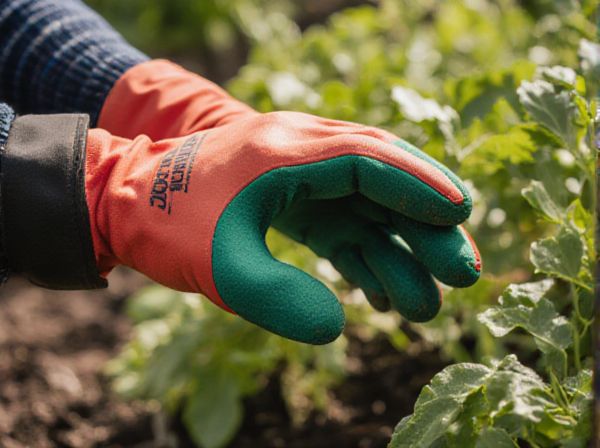
Hand Cultivator vs Claw Cultivator Illustration
A hand cultivator features multiple tines that are ideal for loosening soil and aerating small garden beds with precision. In contrast, a claw cultivator typically has curved, claw-like prongs designed to break up compacted soil and remove weeds effectively. Choosing between them depends on the specific gardening task, with the hand cultivator excelling in delicate soil work and the claw cultivator better suited for tougher, more stubborn soil conditions.
Table of Comparison
| Feature | Hand Cultivator | Claw Cultivator |
|---|---|---|
| Design | Small handheld tool with 3-5 curved tines | Multiple claw-like prongs, often metal, attached to a handle |
| Primary Use | Loosening soil, weeding in small garden beds | Breaking up compacted soil, aeration over larger areas |
| Size | Compact, easy for close, precise work | Larger, suited for wider coverage |
| Effort Required | Low to moderate, ideal for light gardening tasks | Moderate to high, effective for tough soil conditions |
| Best Soil Type | Soft to medium soil | Hard or compacted soil |
| Durability | Generally lightweight, less durable | Sturdy metal build, highly durable |
| Price Range | Low ($5-$15) | Moderate ($15-$30) |
Overview of Hand Cultivator and Claw Cultivator
Hand cultivators feature multiple curved tines attached to a handle, ideal for loosening soil and removing weeds in tight spaces. Claw cultivators typically have claw-shaped metal prongs designed for breaking up compacted soil and aerating larger garden areas efficiently. Both tools enhance soil health but differ in design and best-use scenarios, with hand cultivators suited for precision tasks and claw cultivators for broader soil preparation.
Design and Construction Differences
Hand cultivators feature a compact design with short, sturdy handles and multiple curved tines for precise soil aeration and weed removal in small garden beds. Claw cultivators are typically larger with longer handles and broader, claw-shaped tines built for breaking up compacted soil and turning larger areas efficiently. The construction of hand cultivators emphasizes maneuverability and control, while claw cultivators prioritize strength and leverage for heavier soil work.
Primary Functions and Uses
Hand cultivators are designed for loosening soil, weeding, and aerating small garden beds with precision, making them ideal for delicate plants and tight spaces. Claw cultivators feature multiple curved tines that efficiently break up compacted soil and remove weeds over larger areas, suited for medium to large garden plots. Both tools enhance soil health but differ in scale and intensity of cultivation tasks.
Ease of Handling and Ergonomics
Hand cultivators offer superior ease of handling due to their lightweight design and smaller size, which reduces user fatigue during extended gardening tasks. Claw cultivators often feature ergonomic handles shaped to provide a comfortable grip, minimizing strain on the wrists and forearms. Both tools prioritize ergonomic considerations, but hand cultivators are typically favored for precision and maneuverability in tight spaces.
Effectiveness in Different Soil Types
Hand cultivators excel in lightweight, sandy soils by allowing precise aeration and weed removal while causing minimal soil disturbance. Claw cultivators perform better in heavy, clay-rich soils due to their robust tines that break up compacted layers and improve soil structure effectively. Selecting the appropriate cultivator enhances soil health and crop yield by matching tool design to specific soil conditions.
Maintenance and Durability
Hand cultivators typically require minimal maintenance, with occasional cleaning and occasional sharpening of tines to maintain efficiency. Claw cultivators, designed with more robust steel construction, offer superior durability and resist bending under heavy use, but they may need more frequent inspection for joint wear and rust prevention. Proper storage and routine cleaning extend the lifespan of both tools, ensuring sustained performance in soil cultivation tasks.
Pros and Cons of Hand Cultivators
Hand cultivators offer precision and control for small-scale gardening, making them ideal for delicate tasks like weeding and aerating soil around plants. Their lightweight design and ergonomic handles reduce fatigue and enhance maneuverability in tight spaces. However, hand cultivators may require more physical effort and time compared to claw cultivators, which are better suited for larger areas due to their wider reach and more aggressive soil disruption.
Pros and Cons of Claw Cultivators
Claw cultivators provide efficient soil aeration and weed removal with their multiple sharp tines, making them ideal for loosening compacted soil and preparing garden beds quickly. They can be less precise around delicate plants compared to hand cultivators due to their larger size and aggressive digging action. The durability and ease of use for larger areas offset drawbacks like limited maneuverability in tight spaces.
Choosing the Right Cultivator for Your Garden
Hand cultivators offer precise control for small garden beds and delicate plants, while claw cultivators are better suited for breaking up hard soil and larger areas. Selecting the right cultivator depends on soil type, garden size, and plant sensitivity, ensuring efficient cultivation and improved soil aeration. Ergonomic design and durable materials enhance usability and longevity for both tools.
Expert Tips for Maximizing Tool Performance
Hand cultivators offer precise soil aeration and weed control, ideal for small garden beds and delicate plants, while claw cultivators excel in breaking up compacted soil over larger areas due to their robust design and multiple tines. Experts recommend selecting a hand cultivator with ergonomic handles and high-carbon steel tines for durability and reduced fatigue during prolonged use. For claw cultivators, maintaining sharp, rust-resistant tines and using proper downward pressure enhances soil penetration and overall cultivation efficiency.
Hand Cultivator vs Claw Cultivator Infographic

 gardendif.com
gardendif.com